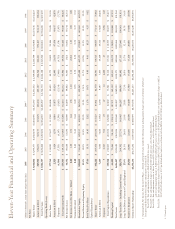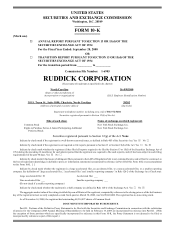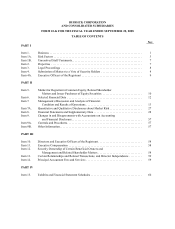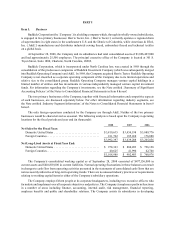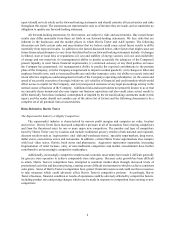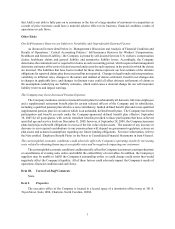Harris Teeter 2008 Annual Report Download - page 11
Download and view the complete annual report
Please find page 11 of the 2008 Harris Teeter annual report below. You can navigate through the pages in the report by either clicking on the pages listed below, or by using the keyword search tool below to find specific information within the annual report.7
that A&E is not able to fully pass on to customers or the loss of a large number of customers to competitors as
a result of price increases could have a material adverse effect on its business, financial condition, results of
operations or cash flows.
Other Risks
Our Self-Insurance Reserves are Subject to Variability and Unpredictable External Factors
As discussed in more detail below in “Management’s Discussion and Analysis of Financial Condition and
Results of Operations—Critical Accounting Policies—Self-insurance Reserves for Workers’ Compensation,
Healthcare and General Liability,” the Company is primarily self-insured for most U.S. workers’ compensation
claims, healthcare claims and general liability and automotive liability losses. Accordingly, the Company
determines the estimated reserve required for claims in each accounting period, which requires that management
determine estimates of the costs of claims incurred and accrue for such expenses in the period in which the claims
are incurred. The liabilities that have been recorded for these claims represent our best estimate of the ultimate
obligations for reported claims plus those incurred but not reported. Changes in legal trends and interpretations,
variability in inflation rates, changes in the nature and method of claims settlement, benefit level changes due
to changes in applicable laws, and changes in discount rates could all affect ultimate settlements of claims or
the assumptions underlying our liability estimates, which could cause a material change for our self-insurance
liability reserves and impact earnings.
The Company may Incur Increased Pension Expenses
The Company maintains certain retirement benefit plans for substantially all domestic full-time employees
and a supplemental retirement benefit plan for certain selected officers of the Company and its subsidiaries,
including a qualified pension plan which is a non-contributory, funded defined benefit plan and a non-qualified
supplemental pension plan for executives which is an unfunded, defined benefit plan. The Company has frozen
participation and benefit accruals under the Company-sponsored defined benefit plan effective September
30, 2005 for all participants, with certain transition benefits provided to those participants that have achieved
specified age and service levels on December 31, 2005; however, at September 28, 2008, the Company’s pension
plans had projected benefit obligations in excess of the fair value of plan assets. The amount of any increase or
decrease in our required contributions to our pension plans will depend on government regulation, returns on
plan assets and actuarial assumptions regarding our future funding obligations. For more information, refer to
the Note entitled “Employee Benefit Plans” in the Notes to Consolidated Financial Statements in Item 8 hereof.
The current global economic conditions could adversely affect the Company’s operating results by increasing
costs related to obtaining financing at acceptable rates and by negatively impacting our customers
The cu r rent global economic conditions could materially affect the Company’s customers causing reductions
or cancellations of existing sales orders and inhibit the collectibility of receivables. In addition, the Company’s
suppliers may be unable to fulfill the Company’s outstanding orders or could change credit terms that would
negatively affect the Company’s liquidity. All of these factors could adversely impact the Company’s results of
operations, financial condition and cash flows.
Item 1B. Unresolved Staff Comments
None.
Item 2. Properties
The executive office of the Company is located in a leased space of a downtown office tower at 301 S.
Tryon Street, Suite 1800, Charlotte, North Carolina, 28202.


